Key Facts
- Only one out of Montana’s ten snake species is venomous.
- The prairie rattlesnake happens to be that especially dangerous species and its venom is both hemotoxic and neurotoxic.
- The eastern racer which can be found all over the state can grow to 75 inches in length and is known for its habit of raising its head to search for prey.
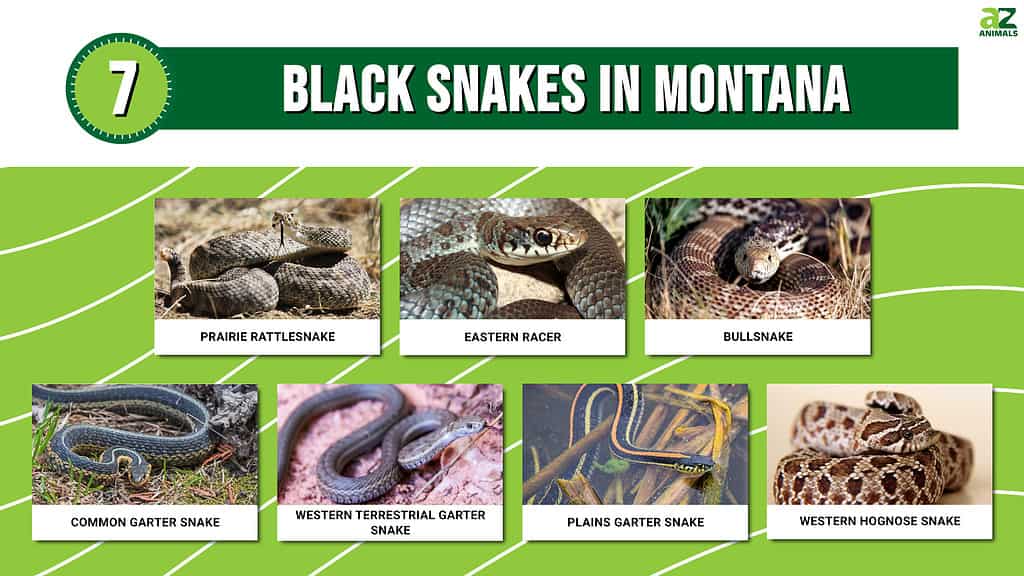
Often called the Big Sky Country, Montana is known for its vast and stunning landscape.
With famous areas such as Yellowstone National Park and Glacier National Park, it’s no surprise that Montana is home to many fascinating animals. However, although many of its animals are large – such as mountain lions and bears – it is also home to several species of snakes.
There are ten snakes that are native to Montana, of which only one is venomous. So, to help you identify these snakes, we’re going to discuss the black snakes in Montana. Let’s get started!
1. Prairie Rattlesnake (Crotalus viridis)
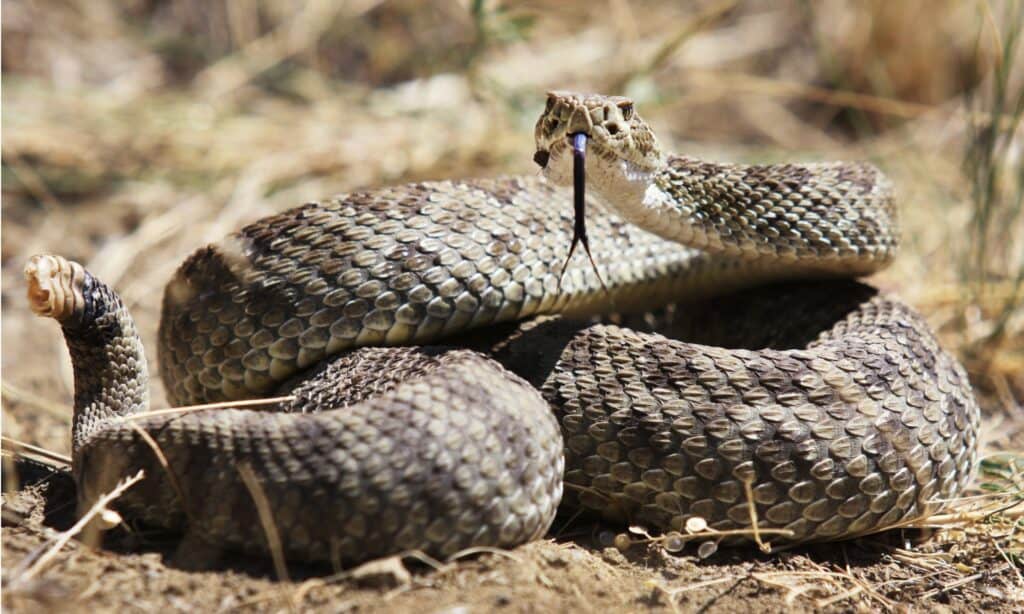
The prairie
rattlesnake
is the only venomous snake in Montana.
©iStock.com/HRossD
We’ll kick off the list with the only venomous snake in Montana – the prairie rattlesnake. Also known as the western rattlesnake, this snake lives everywhere in Montana, with the exception of the northwest corner of the state.
It typically prefers to live in dry, rocky regions, as well as regions with tall grass, mixed coniferous forests, and along riverbanks. Prairie rattlesnakes are 15 to 60 inches long and have heavy bodies with triangular-shaped heads. They are usually tan, brown, or olive green with dark brown or black blotched markings. They also have keeled dorsal scales and a white or yellow belly.
Prairie rattlesnakes are highly venomous, and their venom contains neurotoxic and hemotoxic properties. However, they are shy and prefer to flee from threats rather than stand their ground and attack. Even if you do come across a prairie rattlesnake, it will rattle its tail a lot in warning or coil its body, then raise its head up off the ground first in a defensive posture before it actually strikes.
When it comes to prey, prairie rattlesnakes are ambush predators and feed mainly on small mammals and birds.
2. Eastern Racer (Coluber constrictor)
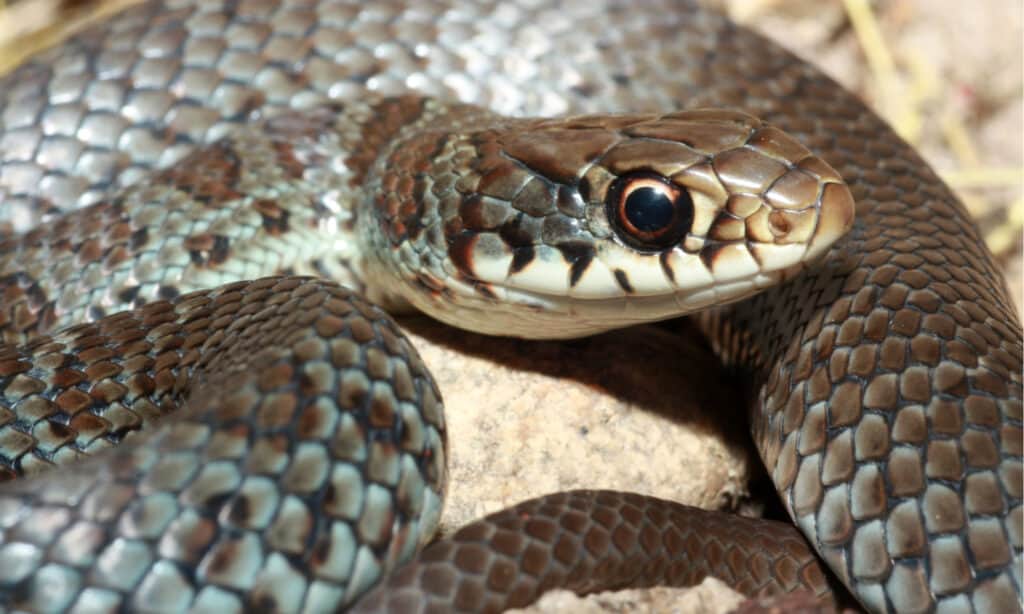
Eastern racers swallow their prey alive.
©Michael Benard/Shutterstock.com
Another black snake in Montana is the eastern racer which is usually a glossy black or grey with a white or yellow belly. Eastern racers are 20 to 75 inches long and have slender bodies. They are widespread across Montana and live in forests and grasslands. They are quick, active snakes and have excellent eyesight. One of the most common postures that they adopt is to paise with their heads raised up off the ground as they look for prey.
Despite their scientific name, eastern racers are not truly constrictors. Instead of coiling their body around their prey until it dies, they simply subdue it before swallowing it alive. Eastern racers prey on small mammals, birds, reptiles, amphibians, and other snakes. Although they are not venomous snakes, you should never attempt to handle an eastern racer as they are aggressive and will bite if threatened. They also release a foul-smelling musk.
3. Bullsnake (Pituophis catenifer sayi)

Bullsnakes are the largest snakes in Montana.
©iStock.com/92968526
There are six subspecies of the gopher snake and bullsnakes are the subspecies which are common in Montana. Bullsnakes are the largest snakes in Montana and can reach lengths of up to 72 inches. They have yellowish bodies with large dark brown or black blotches. Due to their appearance, they can sometimes be mistaken for the prairie rattlesnake which can lead to them being mistakenly killed in some cases. Bullsnakes are constrictors but sometimes mimic rattlesnakes by vibrating their tail in the leaf litter, which is another reason they are easily mistaken.
Bullsnakes prefer to live in dry regions such as prairies and pastures. They are widespread across Montana but are most prolific in areas where there are high rodent populations. However, they don’t prey solely on rodents as they are well known for their ability to climb trees and raid bird nests.
4. Common Garter Snake (Thamnophis sirtalis)

Common garter snakes are immune to the poison produced by toads.
©iStock.com/Wildnerdpix
The next few black snakes in Montana are garter snakes. The first is the common garter snake which is typically 16 to 42 inches long.
These snakes are brown, black, or green with yellow or cream stripes – one down their back and one along either side. They also occasionally have small red spots between the stripes. Common garter snakes are found across the entire state. They live in forests and grasslands near permanent sources of water.
Although common garter snakes are not considered to be dangerous to humans, they are mildly venomous to their prey. Common garter snakes often prey on amphibians and are immune to the poison produced by toads.
5. Western Terrestrial Garter Snake (Thamnophis elegans)
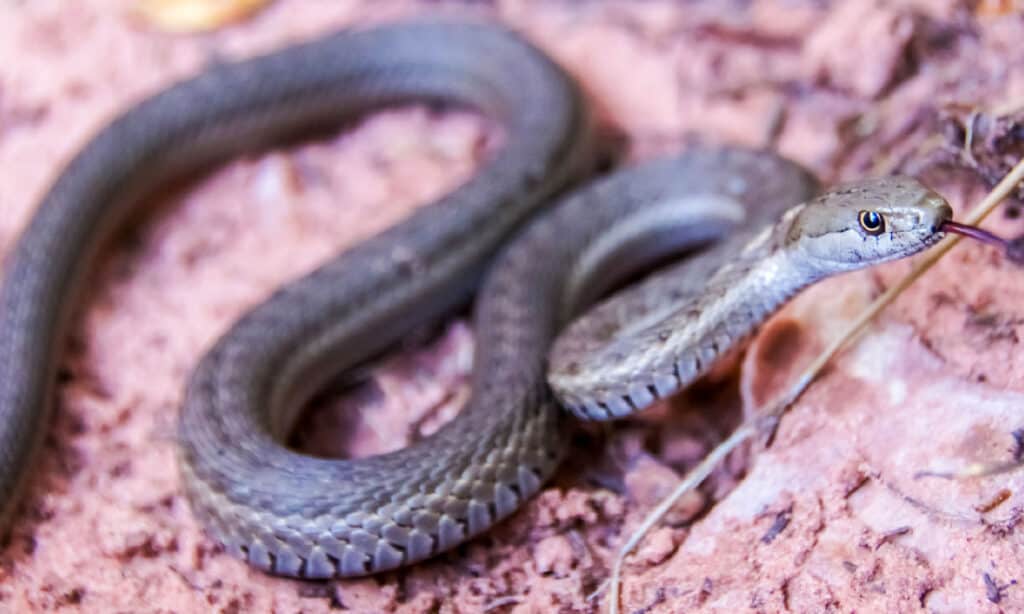
Western terrestrial garter snakes kill prey by constriction.
©iStock.com/yhelfman
The next garter snake is the western terrestrial garter snake which is distinguishable from the common garter snake by its lighter color. They are typically greyish-green but have black spots between their yellow dorsal and lateral stripes.
However, sometimes these snakes can have entirely dark or black coloring. Western terrestrial garter snakes can be found all over Montana, with the exception of the northeast corner. They live in virtually all habitats – including forests, prairies, and pastures.
Western terrestrial garter snakes often kill their prey by constriction, but they also contain mild venom in their saliva. Despite this, they are not considered to be truly venomous and are not dangerous to humans. Bites from these snakes typically cause only localized swelling and itching.
6. Plains Garter Snake (Thamnophis radix)

Plains garter snakes are known to tolerate cold weather.
©Alyssa Metro/Shutterstock.com
The Plains garter snake has a similar appearance to the previous two garter snakes that we’ve mentioned. It is greyish-green, brown, or black with yellow or orange stripes and black bars on its lips. Plains garter snakes are found in the central and eastern regions of Montana. Although they can occur in most habitats, they are most often found at lower elevations near a source of water – such as swamps, ponds, and streams.
Plains garter snakes are known for being particularly tolerant of cold weather and often emerge from their brumation on warm, sunny days to bask in the sun. Outside of their brumation period, plains garter snakes are usually active between April and October.
7. Western Hognose Snake (Heterodon nasicus)
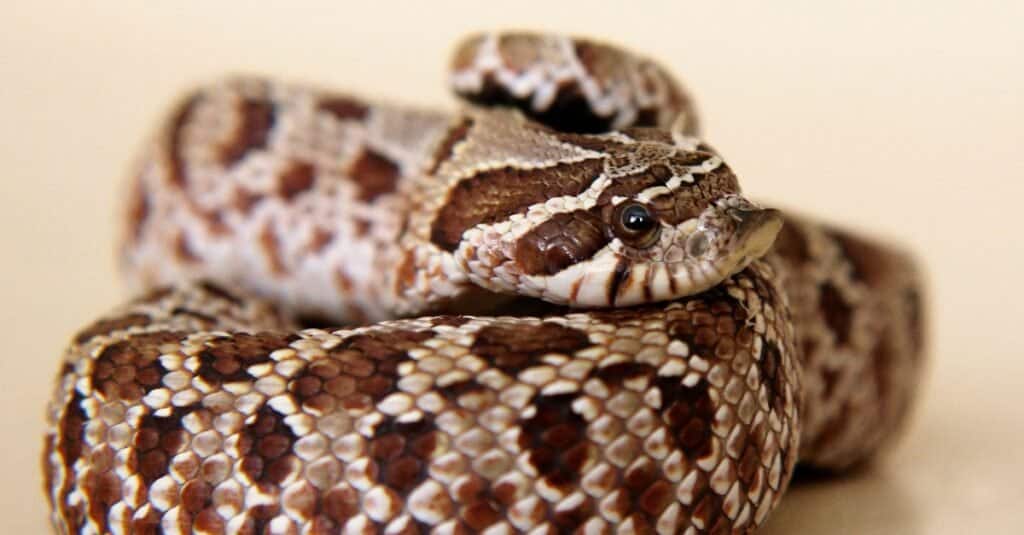
The western hognose snake has a thick body and is slightly smaller than the eastern hognose.
©iStock.com/Iuliia Morozova
The final black snake in Montana is the western hognose snake which is also known as the plains or prairie hognose snake. Although their appearance can vary, these snakes are typically a light or tan brown color with dark brown to black blotches – again quite similar to the prairie rattlesnake.
However, the most distinctive feature of the western hognose snake is its upturned snout used for digging and burrowing the soil. Western hognose snakes are found in the central and eastern regions of the state up to the Rocky Mountains, or in any areas with loose soil.
Western hognose snakes prey mainly on amphibians. They use the mild venom which is produced in their rear fangs to subdue prey. When threatened, western hognose snakes sometimes flatten their necks and act like a cobra but they are not dangerous to humans.
Summary of the 7 Black Snakes in Montana
| Name of Snake | Region |
| Prairie Rattlesnake (Crotalus viridis) | Found statewide, except in the northwest corner |
| Eastern Racer (Coluber constrictor) | Widespread across the state but prefer forests and grasslands |
| Bullsnake (Pituophis catenifer sayi) | Found statewide but prefer prairies and pastures and areas with high rodent populations. |
| Common Garter Snake (Thamnophis sirtalis) | Found statewide, in forests and grasslands near water sources |
| Western Terrestrial Garter Snake (Thamnophis elegans) | Found statewide, except in the northeast corner |
| Plains Garter Snake (Thamnophis radix) | Central and eastern regions near water sources |
| Western Hognose Snake (Heterodon nasicus) | Central and eastern region up to the Rocky Mountains |
Other Reptiles Found In Montana
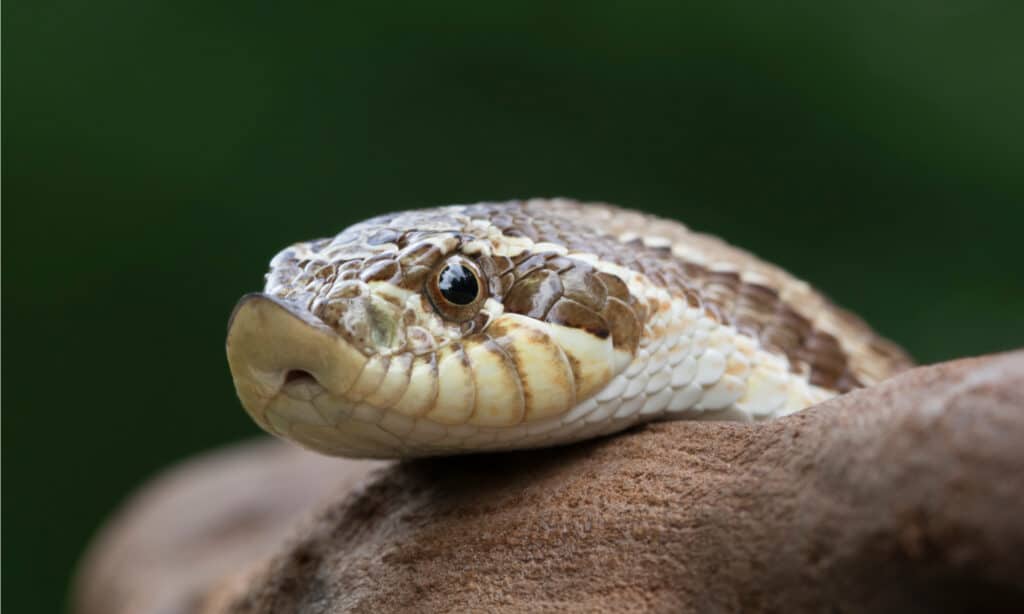
Western Hognose Snake (Heterodon nasicus) are one of the many reptile species found in Montana.
©Mark_Kostich/Shutterstock.com
Montana has a total of 34 amphibian and reptile species. Fortunately, none of these species are at risk of extinction or endangerment, although some of them are regarded as species of concern by the Montana Department of Fish, Wildlife, and Parks.
Additionally, in Montana, the Western Skink stands out as the only lizard that seems to have a sleek and glossy skin texture and displays a blue-colored tail in juveniles and young adults.
With that said, here is a list of other reptiles that can be found in Montana:
- Greater short-horned lizard
- Garter snake
- Prairie rattlesnake
- Common garter snake
- Eastern racer
- Milk Snake
- Rubber boa
- Western hognose snake
- Western terrestrial garter snake
- Smooth green snake
- Gopher snake
- Bullsnake
Other Dangerous Animals Found In Montana
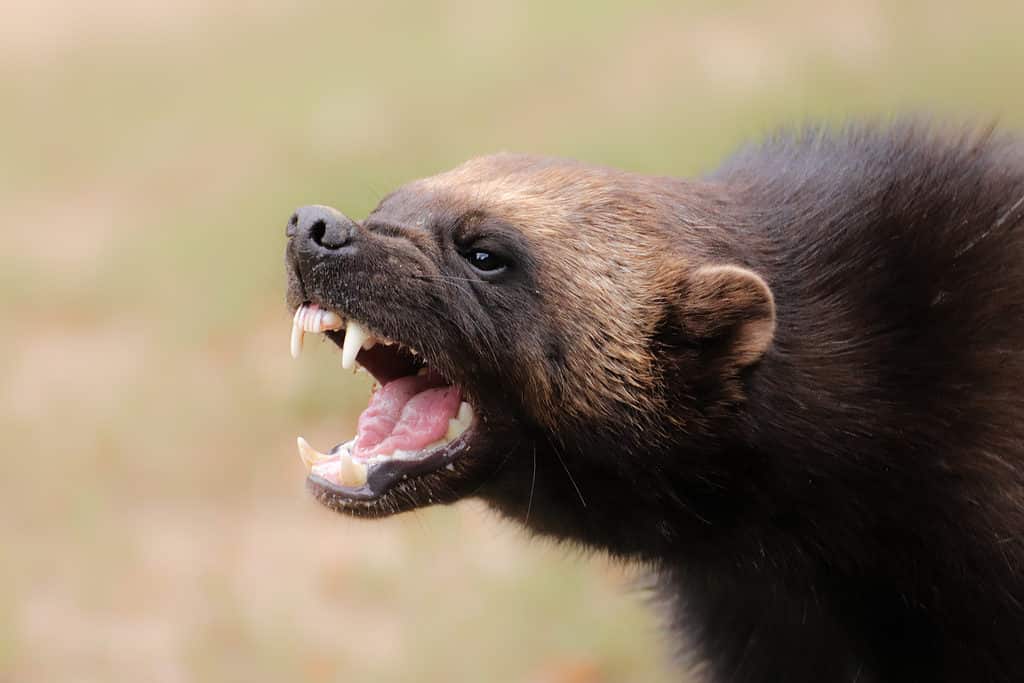
Wolverine shows its sharp teeth in a threatening stance
©DenisaPro/Shutterstock.com
The wolverine is a solitary, carnivorous animal that is known for its aggressive behavior. These mammals not only look like mini-grizzly bears but also resemble them in equivalence to their behavior and range – they are notorious for competing with the grizzly for a freshly killed animal. The wolverine has paws that are equipped with razor-sharp claws that are adept at crushing bones and this dangerous predator is known to be very cunning. It can sneak up on you and attack when you least expect it and its 70-pound thick body is one that should be avoided.
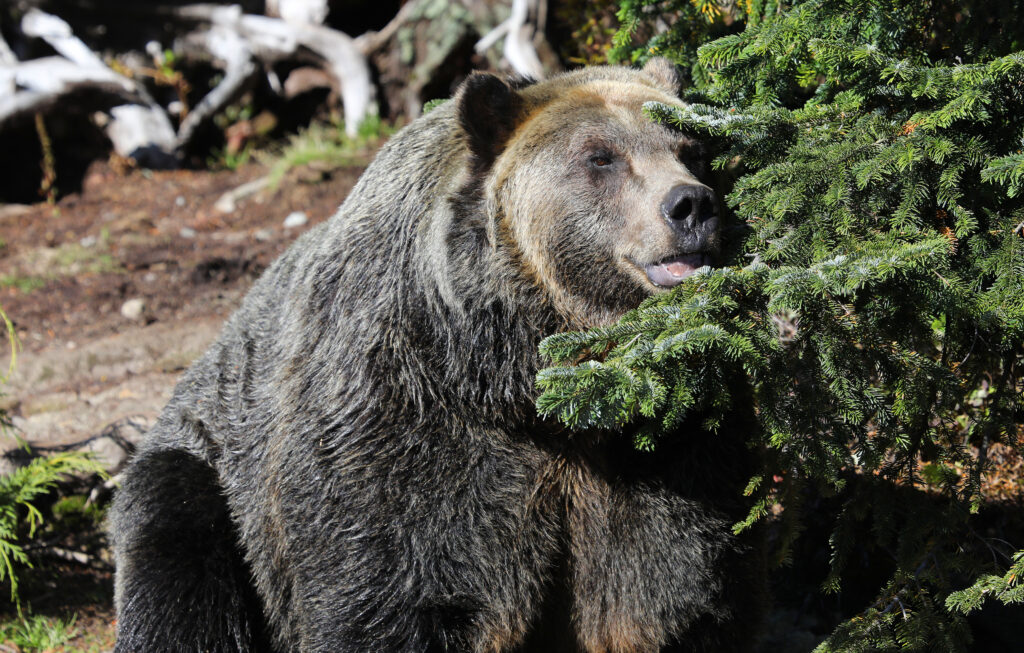
A large grizzly bear near Vancouver in Canada.
©Jacqui Martin/Shutterstock.com
The grizzly bear, also known as the North American brown bear, is a threatened species that is found in various areas of Montana, which has the largest remaining grizzly population. Growing up to 800 pounds and reaching heights of up to 7 feet, this brown bear prefers to avoid humans and will only attack when it feels threatened or if protecting its cubs. However, when they do attack, they are among the most lethal creatures in the wild with a bite force of 1,000 pounds per square inch (psi) that could most likely take just a few seconds to split a body in half. As one of the fastest bears in the world, they can easily outrun a human so you should not attempt to outrun this bear.
The photo featured at the top of this post is © iStock.com/Wildnerdpix
Discover the "Monster" Snake 5X Bigger than an Anaconda
Every day A-Z Animals sends out some of the most incredible facts in the world from our free newsletter. Want to discover the 10 most beautiful snakes in the world, a "snake island" where you're never more than 3 feet from danger, or a "monster" snake 5X larger than an anaconda? Then sign up right now and you'll start receiving our daily newsletter absolutely free.
Thank you for reading! Have some feedback for us? Contact the AZ Animals editorial team.






